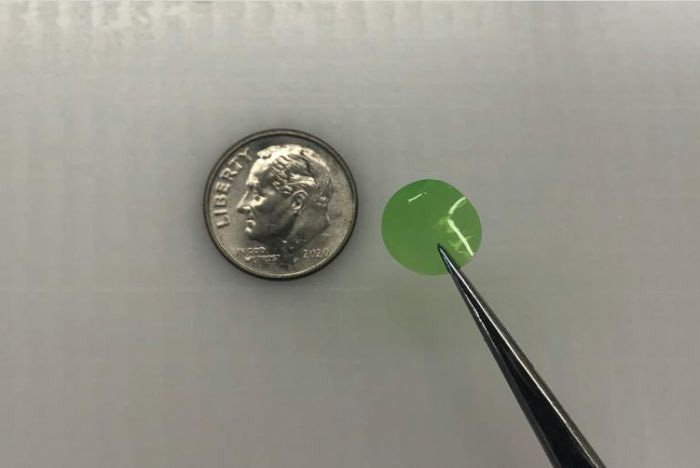'Luminous' membrane sensor technology can measure blood oxygen
The technology was developed by Tufts University of Massachusetts, in the laboratory of Professor David Kaplan. It now takes the form of a thin membrane disc smaller than a coin and surgically inserted beneath layers of skin similar to a tattoo. The membrane is composed of a permeable gel made mainly of fibroin - a protein derived from silk. Fibroin is not only biodegradable and biocompatible, but also does not change the chemical properties of the substances added to it.

The sensor membrane is normally green but glows purple when exposed to near-infrared light in the presence of oxygen.
In this case, the compound, called PdBMAP, glows when exposed to near-infrared light - the greater the amount of oxygen in the immediate environment, the shorter the glow time. Depending on how it was made, the sensor will harmlessly dissolve in the body over a period of weeks to a year.
In one experiment, the scientists inserted a sensor into the skin of a mouse, and then shone near-infrared light through the rodent's skin at that location. The sensor responds by glowing, with the glow duration accurately representing the oxygen level of the interstitial fluid around it, the oxygen level in that fluid reflecting the oxygen level in the blood.
Although blood oxygen can be measured non-invasively using pulse oximeters, it is hoped that once further developed, the sensor technology could also be used to measure the amount of oxygen in the blood. other substances in the blood, such as glucose, lactate, or electrolytes. Currently, such measurements must be obtained via a blood sample or by attaching the patient to complex equipment.
"We can envision many situations where a sensor like a tattoo under the skin could be useful," said Thomas Falcucci, a PhD student in Kaplan's lab who developed the device. That is often in situations where people with chronic conditions need to be monitored for long periods of time outside of a traditional clinical setting. We can monitor many blood components using a sensor membrane under the skin."
- Introducing a new way to measure blood sugar
- New sensors help measure heavy metal concentrations in human blood
- How many types of fingerprint sensor under the screen? Which type of
- Contact lenses for diabetic patients
- Breakthrough technology that cleans water around the globe
- Structure and working principle of oxygen generator
- Discovery that goes down in history: The surface of the Moon has enough oxygen for 8 billion people to live for 100,000 years
- Found a new way to measure blood pressure at a very low cost, which is ... shooting video selfie
- Human eye-based sensors will be popular on Android and iPhone
- Robots treat snoring
- US ambition to bring oxygen production to Mars
- Measure the hotness of chili paste with nanotube
 The US company is about to build a supersonic passenger plane of 6,000km / h
The US company is about to build a supersonic passenger plane of 6,000km / h Japan develops avatar robot as in fiction film
Japan develops avatar robot as in fiction film Australia tested the world's first mango picking robot
Australia tested the world's first mango picking robot America develops technology to separate water from animal waste
America develops technology to separate water from animal waste